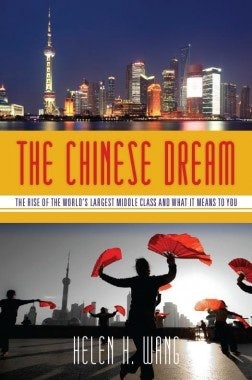"The Chinese Dream: The Rise of the World's Largest Middle Class and What It Means to You" (Bestseller Press, 2010, $17, Paperback)#

The Chinese Dream, by Helen H. Wang
With companies around the world rushing to tap the growing Chinese middle class, a key consumer demographic that's projected to number 800 million within the next decade and a half, The Chinese Dream: The Rise of the World's Largest Middle Class and What It Means to You ($17, paperback) by Helen H. Wang looks to demystify, examine, and explain the economic rise of China -- and how many of the more alarmist projections about China's future role in the world are both overstated and counterproductive. With the media narrative about Sino-US relations often focusing on contention and dissonance between the two powers, in The Chinese Dream, Helen Wang digs deeper and finds that closer cooperation could bring about the cure to America's economic doldrums as well as China's deepening environmental, health, and energy crises.
Looking exclusively at China's highly entrepreneurial middle class, a brand-savvy, economically independent, educated group that already numbers in the hundreds of millions, and putting forth a profile of this important demographic based on interviews, personal stories and historical portraits, The Chinese Dream is enlightening for anyone interested not only in the economic importance of the Chinese middle class today, but also of this group's cultural and political implications for the China of tomorrow. Unlike other books that focuses on the extremes evident in Chinese society, The Chinese Dream is filled with nuance, filling in the gray areas of the country's emerging consumer class through interviews of everyone from high-powered executives to migrant workers, offering a thoughtful analysis on where these individuals are taking China, and the opportunities that are being created in the process.
Jing Daily recently discussed The Chinese Dream with author Helen Wang, in a short Q&A about the importance of the emerging Chinese middle class, the strains that they could put on the global economy, and the challenges and opportunities that this millions-strong group presents to companies (and countries) around the world.
Jing Daily (JD): In The Chinese Dream, you take a very positive view of China’s expanding middle class. Do you think the emergence of this group could have any negative impact on the global economy? If so, how?#
Helen Wang (HW)#
: A major negative impact of China's expanding middle class would be a strain on resources. A large Chinese middle class is likely to drive up prices for resources such as oil and raw materials. Another negative impact is damage to the environment. As hundreds of millions of the Chinese middle class can afford to drive cars and own homes with modern appliances, it will cause serious pollution, which can be economically costly to clean up. However, these challenges have also created enormous opportunities in renewable energy and clean tech fields.
JD: Capitalism and Communism coexist in China, mainly peacefully in your view. What do you think of recent examples of contention between the two forces, for example the recent luxury advertising ban enacted in Beijing, which is aimed at fighting conspicuous consumption? Will this be an ongoing or intensifying issue?#
HW#
: Communism exists in China in name only. The Communist Party of China mainly practices capitalism. Conspicuous consumption causes a lot of social anxiety as many people in China feel they have to "keep up with the Joneses." On one hand, the Chinese government encourages consumption. On the other hand, they are concerned that conspicuous consumption will cause social problems such as resentment and discontent.
In the West, individuality counterbalances this. In China, the collective culture creates more peer pressure that is very difficult to resist. I think this could be an ongoing issue, but not necessarily an intensifying one. The challenge for luxury goods companies is to find creative ways to reach their customers.

Author Helen Wang
JD: At the moment, most the world sees the China market as an opportunity, something that's particularly true in the luxury realm. How much does the middle class have to do with that?#
HW:#
In China, not just rich people buy luxury goods. Many middle class people also buy luxury goods because of the prestigious social status the luxury brands entail. A recent McKinsey study indicates that luxury sales in China will reach US$27 billion in 2015, and the upper middle class will account for 22 percent of the luxury market in China. Again, this depends on how you define the Chinese middle class. According to my definition (annual household incomes from US$10,000 to $60,000), a larger percentage of luxury sales will come from the Chinese middle class.
JD: Last year, we interviewed Handel Jones, author of ChinAmerica, who said that education, health and the Internet are going to be the most lucrative sectors for Western companies to tap the Chinese middle class. Would you agree with this? Are there any other sectors you would add?#
HW:#
Definitely, the healthcare and education sectors will provide lucrative opportunities for Western companies. I am not sure about the Internet as it’s currently dominated by domestic companies. But if you look at the e-commerce sector, it could be a game changer. Recently, many VCs have invested in e-commerce and group buying sites as China’s internet users are approaching half a billion.
I think the consumer products sector, particularly in the areas of luxury goods and big ticket items such as automobiles, LCD TVs, and smartphones, will see increasing opportunities for Western companies. I would also add the clean tech sector. Western companies are leading in technology in this field.
JD: What would you say are the key strategies for Western businesses to enter the China market? What about vice versa - what do you think are the major difficulties facing domestic Chinese brands that are aiming to go international?#
HW:#
The key strategies for Western companies to enter China market are: a)
Study the China market, as China is very different#
. What works in their home markets may not work in China; b)
Work with local partners or hire local talent#
. This is very critical for Western companies to succeed in China; c)
Adapt your products to Chinese consumers’ taste#
. Western companies have opportunities to reposition their products in China. For example, Pizza Hut positioned itself as a trendy and upscale restaurant chain in China and it’s been very successful.
For Chinese brands going abroad, major difficulties will be: a) Quality or the perception of quality; b) Brand recognition; c) Understanding and following international laws.